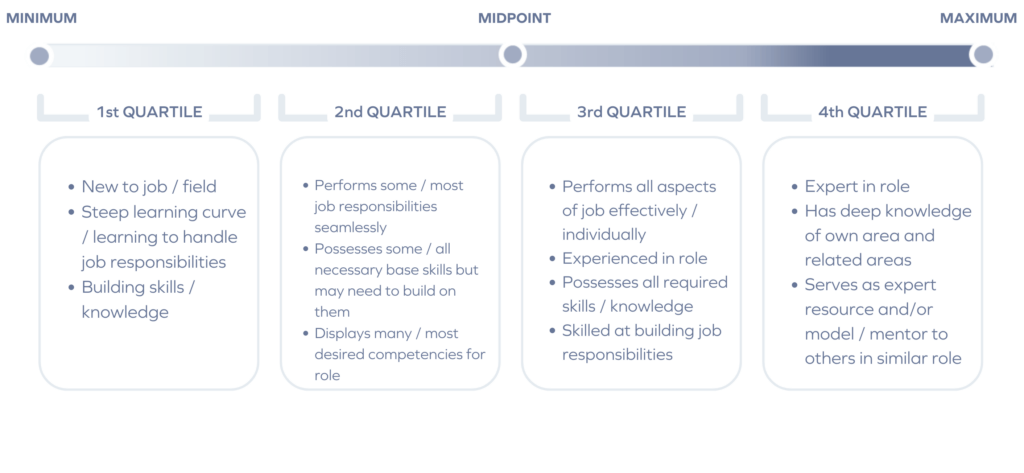
Compensation 101: Building Consistent Salary Ranges and Bands from Scratch

Key Insights
- With new pay transparency laws in New York and California, companies with as few as four employees now need to consider their compensation philosophy.
- For early-stage companies that might not have HR resources or guidance yet, establishing a compensation philosophy often falls to founders.
- Establishing salary ranges can help founders communicate their company’s compensation philosophy and stay compliant with the new pay transparency laws.
New year, new laws. One of the latest: California’s Pay Transparency Law. The new law states that companies with 15 or more employees and at least one employee in California must include pay ranges in all job postings. According to enforcement guidance issued by the California Labor Commission, the pay scale must be included in the job posting if the position may ever be filled in California, either in-person or remotely. New York City and New York State have recently enacted similar legislation. It is crucial for founders of early-stage companies to stay updated on these new regulations and understand their potential impact on their businesses.
To comply with the pay transparency laws, companies need to post salary ranges in “good faith,” i.e., a salary range the company honestly believes and reasonably expects it will pay for the role at the time of posting the job opening.
Deeper insight: Pay Transparency is Here to Stay. How Can You Build Salary Ranges in Good Faith?
One way to help simplify the compliance process is by standardizing your company’s compensation structure with clear salary ranges and pay grades/bands. While this doesn’t guarantee compliance, it does help streamline the process. But the benefits of this standardization exercise go beyond helping to meet legal requirements. Establishing a consistent compensation structure can also promote pay equity and help foster a culture of fairness and transparency throughout your organization. It is also a prime opportunity for founders to take an active role in shaping the company culture and values.
While some companies may have already established compensation bands, for many ScaleUps, this is a new endeavor. So, how should companies think about creating salary ranges and pay grades/bands if they need to start from scratch?
Here are seven key considerations to help founders or early-stage HR leaders establish consistent and fair salary ranges.
1. Define your compensation philosophy
Your compensation philosophy explains the “why” behind your pay decisions. It provides guidance to your organization on how to make pay decisions. Your philosophy should include how you approach each compensation element (i.e., base salary, bonus, target total cash, equity). You will need to determine what proportion of pay is tied to base salary versus short-term (cash bonus) or long-term incentives (equity). You will also need to specify market targets (i.e., percentiles) for each compensation component.
2. Conduct a job analysis based on internal data to align on job families, roles, and levels
First outline the key responsibilities, qualifications, and day-to-day tasks for each role at your organization. There are several ways to do this:
- Leveraging your own general knowledge of the organization
- Observing employees in their roles
- Conducting surveys
- Referencing job descriptions
- Interviewing employees
You will then group the roles at your organization into the appropriate job families and levels (e.g., manager, senior manager, director). Once you’ve established these groupings, stack rank the importance of these roles to your organization.
3. Leverage broad-based compensation market data based on job family and level
Market data is key to building pay grades/bands and salary ranges that are competitive. When leveraging market data, you should match your job families and roles to the data based on the overall job description and responsibilities versus relying only on the job title. Sometimes you might have to combine two different roles within the market data to ensure it covers all aspects of your role.
Additionally, it is important to note that many compensation benchmark tools leverage historical salary data and might not reflect current salary trends. Keep this in mind as you build your pay grades/bands and salary ranges.
4. Determine pay grades/bands
Start by grouping positions of similar worth at your company (i.e., they fulfill similar expectations and have similar levels of responsibility). Entry-level positions often act as the starting point of a pay grade/band because they have less training and experience.
Early stage companies might only have 3-4 pay grades/bands, whereas later-stage companies might have upwards of 10. It is important to note that there is no limit to the number of pay grades within an organization.


This is an illustrative example. Sources: University of Florida – HR, Case Western University – HR
5. Build your salary ranges
Now you can begin building your salary ranges. These ranges should include a minimum, midpoint, and maximum dollar (or other currency) value for each role and level. It is common for salary ranges to overlap to enable career progression in a cost-effective way.
6. Educate your managers
You want to ensure your managers understand your company’s pay philosophy so they can more easily explain to candidates and current employees how the organization makes its compensation decisions. This should include how compensation levels are determined, how the bonus plan works, and the ability to speak to equity.
7. Regularly reassess your salary ranges
Building salary ranges isn’t a one-and-done exercise. You will need to reassess your compensation philosophy and adjust as needed. These adjustments will be based on both internal (i.e., cash reserves) and external factors (i.e., market conditions).
Hiring managers should also review the established ranges prior to including them in any job postings. This will help ensure they accurately reflect what the company honestly believes and reasonably expects it will pay based on the specific considerations of the role and fine-tune if necessary. To the extent a posted salary range deviates from a role’s salary band, you should document why.
While salary banding may seem like a daunting task, getting this exercise right will help ready you for the new pay transparency laws coming online. While this work doesn’t replace the compliance process, it is complementary and will help streamline the process. Beyond compliance, a consistent pay policy will help you attract, retain and motivate employees, and build a healthy culture and organization long-term.
Want to discuss further? Onsite’s HR experts can help. Contact us: HRonCall@insightpartners.com
Please note that this guidance is not legal advice. We suggest consulting with an employment lawyer if you have any questions about complying with pay transparency or pay equity laws.








